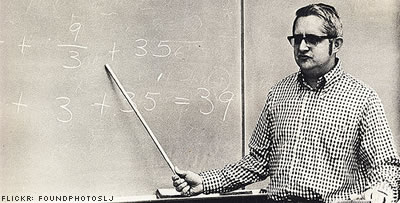Teach the teachers
Thursday, 25 June 2009 | 1 Comment
From The Australian, Technology lesson one: teach the teachers comes this:
... “This isn’t just about teaching teachers to use the technology,” Professor Stoney said.
“It’s about teaching them to use it for learning. How do students learn with technology?
I thoroughly agree.
I’m highly IT literate. I can use a new application presented to me with a little bit of fiddling, I can edit photos, make videos, record and edit sound, build web-sites etc. But, what no-one has been able to show me is how to effectively integrate those skills I have into my teaching. I don’t want online tutorials for using software, I don’t want to be shown how the magic pen draws stars and happy faces – I want to know how this helps me teach, how this helps my students learn.
Sure, there’s lots of teachers blogging and twittering about wizz bang software and web-sites, but few seem to be recording how they apply it in their classroom. Or, they seem to have a different clientele to me.
Some of the reasons I struggle with incorporating technology into my teaching:
- The students at my school required highly structured activities. Even student-centred learning at my school requires significant structure to allow all students to achieve something. My evidence for this is that the subject that is taught with the most structure is probably maths, and it seems to have the least behavioural issues. A structure gives the students at our school, many who come from very unstructured to wildly chaotic homes, security, belonging and an opportunity to learn.
- Combine this with low academic levels. Most students at my school struggle to apply one concept let alone multiple concepts. Whilst we try in many and varied ways to give students the ability to connect concepts and to develop their knowledge, only some students arrive at a level of higher-order thinking that allows them to manipulate, apply and present information. But, many online widgets and activities assume prior understanding of basic concepts.
In terms of technology, I once took a Yr 8 class to the computer lab to undertake an activity about ratios from the Tale site. Beforehand, I had spent about 15 minutes working through it. The students were through it in just a couple of minutes – they didn’t read any of the content, they just pushed buttons till it worked – and then told each other how to get through it.
- Therefore, we need to create our own activities. Absolutely, we do… but that takes time, and with so many other demands, we can’t do everything we want to.
Another misconception worth noting in this post, is that today’s students are technologically savvy. My observation and experience disagrees with that. Much like teaching your mother to program the VCR, the students I teach seem to have a very limited repertoire when it comes to using technology: they know how to text and listen to music on their phone, they know how to search Google, and most could make an ugly WordArt heading for an assignment. Their grasp of technology only extends to what they need to know to entertain themselves and complete basic tasks. I’ve had students in a computing class that have struggled to save their work or open a program. Most students are not using their easy access to technology to independently learn; it’s the “nerds” who would have been reading books and magazines and pulling something apart in the garage when I was at school, now using the internet to learn how to take apart more complicated things.
As I thought about this I realised, that I grew up as computers were growing up. Windows didn’t exist when I started using computers, we learnt about the DOS command line, which taught us about how computers store files. We wrangled with primitive word processors to produce assignments. We learnt how to use the technology because we were interested in the technology. Now, the generation at my school, aren’t interested in the technology but it’s output – which I think means they’re not exploring the technology beyond achieving satisfactory outputs.
My point:
As a teacher, I will continue to read about and watch what others are doing with technology in the classroom, experiment with my own ideas and leave negative comments at training courses that show me how to use an application like a user guide.
As a teacher, I also want to broaden the horizons of my students about what they can achieve with technology, how they can use it to make their life better and increase their opportunities in future employment.
Finally, I want to encourage more teachers to share. Generally, I think teachers hold on to the resources they create like precious gems – sharing must be earnt or paid for, but we should really have moved beyond that. Create a blog or a wiki, share on someone else’s blog or wiki. Imagine if every Year 9 Maths teacher in NSW was asked to create one resource for use on the DER laptops – we’d have enough stuff to cover a year’s worth of classes many times over.
Posted in • In the news • Reflection • Technology • Digital Education Revolution | Short URL: http://mths.co/1553
Post a comment
Commenting is not available in this channel entry.New Subscribe to the …
MathsLinksemail newsletter
Get updates…
About
Simon Job — eleventh year of teaching maths in a public high school in Western Sydney, Australia.
MathsClass is about teaching and learning in a maths classroom. more→
Archive
Elsewhere
 @simonjob
@simonjob
updates via  @mathslinks
@mathslinks
Recently read/found.
Being a Vector is not Mutually Exclusive – Ringo Mok
maths vectorsInstagram
Gcf howie_hua maths

Comments